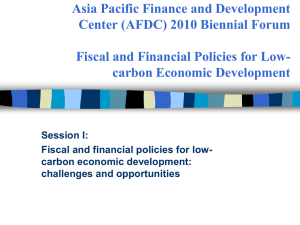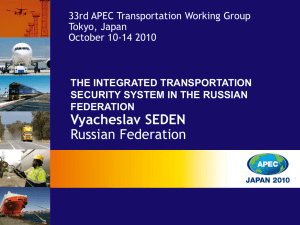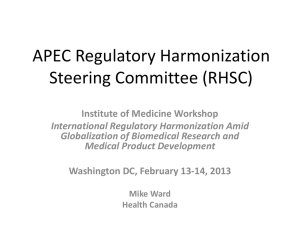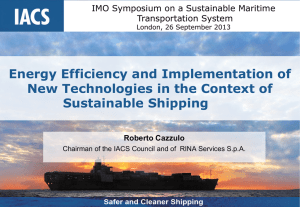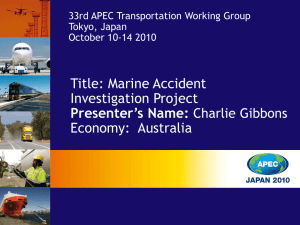TPT 11 12A CR - Asia-Pacific Economic Cooperation
advertisement
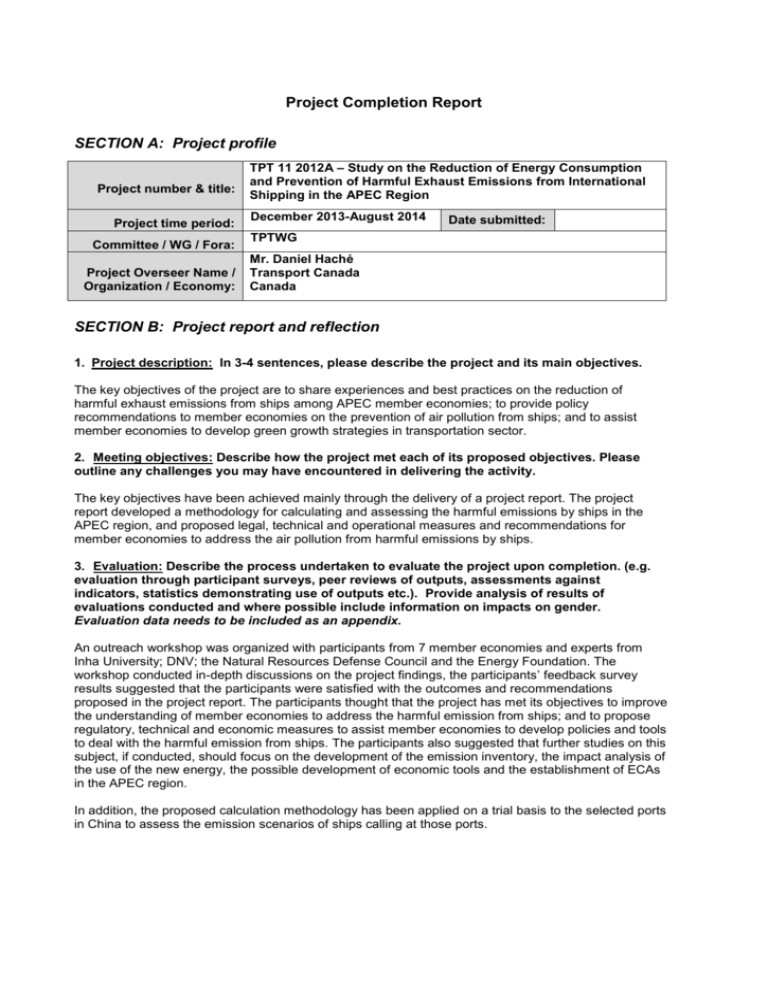
Project Completion Report SECTION A: Project profile Project number & title: Project time period: Committee / WG / Fora: Project Overseer Name / Organization / Economy: TPT 11 2012A – Study on the Reduction of Energy Consumption and Prevention of Harmful Exhaust Emissions from International Shipping in the APEC Region December 2013-August 2014 Date submitted: TPTWG Mr. Daniel Haché Transport Canada Canada SECTION B: Project report and reflection 1. Project description: In 3-4 sentences, please describe the project and its main objectives. The key objectives of the project are to share experiences and best practices on the reduction of harmful exhaust emissions from ships among APEC member economies; to provide policy recommendations to member economies on the prevention of air pollution from ships; and to assist member economies to develop green growth strategies in transportation sector. 2. Meeting objectives: Describe how the project met each of its proposed objectives. Please outline any challenges you may have encountered in delivering the activity. The key objectives have been achieved mainly through the delivery of a project report. The project report developed a methodology for calculating and assessing the harmful emissions by ships in the APEC region, and proposed legal, technical and operational measures and recommendations for member economies to address the air pollution from harmful emissions by ships. 3. Evaluation: Describe the process undertaken to evaluate the project upon completion. (e.g. evaluation through participant surveys, peer reviews of outputs, assessments against indicators, statistics demonstrating use of outputs etc.). Provide analysis of results of evaluations conducted and where possible include information on impacts on gender. Evaluation data needs to be included as an appendix. An outreach workshop was organized with participants from 7 member economies and experts from Inha University; DNV; the Natural Resources Defense Council and the Energy Foundation. The workshop conducted in-depth discussions on the project findings, the participants’ feedback survey results suggested that the participants were satisfied with the outcomes and recommendations proposed in the project report. The participants thought that the project has met its objectives to improve the understanding of member economies to address the harmful emission from ships; and to propose regulatory, technical and economic measures to assist member economies to develop policies and tools to deal with the harmful emission from ships. The participants also suggested that further studies on this subject, if conducted, should focus on the development of the emission inventory, the impact analysis of the use of the new energy, the possible development of economic tools and the establishment of ECAs in the APEC region. In addition, the proposed calculation methodology has been applied on a trial basis to the selected ports in China to assess the emission scenarios of ships calling at those ports. 4. Output indicators: Describe the main project outputs below. This may include workshops, tools, research papers, reports, recommendations, best practices, action plans. Indicators (Edit or Insert rows as needed) # workshops / events # planned # actual Details or notes 1 1 Project workshop 20 20 12 male, 8 female 9 7 6 6 # other organizations engaged 4 3 China, Hong Kong, China, the Republic of Korea; Malaysia; the Philippines; Singapore; Thailand Inha University; DNV; NRDC; Environmental Protection Department of Hong Kong, China; WTI DNV; NRDC; Energy Foundation # publications distributed 1 1 Project report # participants (M/F) # economies attending # speakers engaged # recommendations agreed on Other: 5. Outcomes: Describe any specific medium-term changes to policy, processes or behaviour that can be attributed to result from this activity. Please include details on: What indicators were used to measure medium-term impact? (Example indicators: type/number of policies/ regulations/processes changed, % of businesses conforming to new standards, change in sector’s commercial activity, # individual action plans developed, # agencies using resource or tools etc.) Monitoring plans in place and proposed indicators to measure impacts, including any impacts on gender. Please summarise relevant information. The project has been monitored against its objectives and the work plan during the entire process. The medium-term findings of the project were also carefully evaluated in accordance with the planned outputs. 6. Participants (compulsory for events): Must be gender-aggregated. May be included as appendix. Economy (Insert rows as needed) # male # female Details Other: (see Appendix 1) Comments: What was the approach undertaken for participant nomination/selection and targeting? Please provide details. What follow-up actions are expected? How will participants/beneficiaries continue to be engaged and supported to progress this work? The participant nomination was open to all member economies, in particular, member economies were encouraged to nominate appropriate female participants to attend the workshop. The participants made presentations at the workshop to share experiences in dealing with air pollution from ships within their respective economies. The participants will continue to be engaged during the application of the project findings in selected ports, and a proposal on further studies on this subject will seek inputs from these participants. 7. Key findings: Describe 1-3 examples of key findings, challenges or success stories arising from the project (e.g. research or case studies results, policy recommendations, roadblocks to progress on an issue, impacts on gender). This project proposed solutions to member economies for optimizing fuel consumption, using clean energy and reducing harmful exhaust emissions from ships while maintaining the sound and sustainable development of shipping, so as to achieve green growth and to promote the development of clean and efficient transportation system in the APEC. Through studying the ship SO X and NOX emissions scenario in the port of Incheon and the port of Ningbo, this project examines the existing regulatory, technical, operational and market-based measures addressing the air pollution from ships, and summarizes best practices and proposes recommendation for member economies to develop strategies to deal with the harmful emissions from ships and protect the environment of the entire APEC region. The project proposed a methodology for calculating the SOX and NOX emission from ships, and recommendations to be taken by the Administration, the shipping company and the port to reduce harmful emissions from ships. The specific solutions include: 1) the Administration should adopt regulations to encourage the use of quality fuels and establish monitoring and reporting mechanisms; 2) the shipping company should apply new techniques to retrofit the main and auxiliary engines, to optimize voyage by slowing steaming and keeping constant speed; and to use new and clean energy such as liquefied natural gases; and 3) the port should take incentive measures to encourage ships to switch to low-sulphur fuels. 8. Next steps: Describe any planned follow-up steps or projects, such as workshops, postactivity evaluations, or research to assess the impact of this activity. How will the indicators from Question 5 be tracked? How will this activity inform any future APEC activities? As a follow-up step, the main findings of the project will be applied to selected ports in member economies on a trial and voluntary basis. It is also expected that a new project concept note would be put forward to the TPTWG to further study the social-economic impact of using the low-sulphur fuels and the application of economic measures to address the harmful emission from ships in the APEC region. The outcomes of the trail application and the new project concept note will be submitted to member economies and the TPTWG for consideration and endorsement in accordance with the APEC practices and procedures. 9. Feedback for the Secretariat: Do you have suggestions for more effective support by APEC fora or the Secretariat? Any assessment of consultants, experts or other stakeholders to share? The Secretariat examines feedback trends to identify ways to improve our systems. The project did not encounter any difficulties as the Secretariat provided efficient and effective support where necessary. SECTION C: Budget Attach a detailed breakdown of the APEC- provided project budget, including: Planned costs: (using most recently approved budget figures) Actual expenditures Variance notes: An explanation of any budget line under- or over-spent by 20% or more. All figures in USD Unit Unit Rate APEC Funding Variance notes Planned cost Actual expenditure Direct Labor Contractor (consultancy and administrative support fees) Senior researchers 90 days $300 $27,000 $27,000 Researchers 105 days $200 $21,000 $21,000 Translator’s fee 40 days $60 $2,400 $2,400 short-term clerical fees 40 days $50 $2,000 $2,000 $52,400 $52,400 Sub-total All figures in USD Unit Unit Rate APEC Funding Variance notes Planned cost Actual expenditure $2000/day $4,000 $4,000 $500/day $1,000 $1,000 $5,000 $5,000 Workshop room rent 2 days equipment rent and other hosting fees Sub-total Other items Publication/distribution of report (hard copy and CDs) 100 copies $20/copy $2,000 $2,000 Photocopying (papers and documents for research) 200 copies $8/copy $1,600 $1,600 Communications fee (telephone, fax, courier) $660 $660 Sub-total $4,260 $4,260 Total $61,660 $61,660 SECTION D: Appendices Please attach the following documentation to the report as required. Note that the participant contact list is a mandatory requirement for all Project completion reports. Appendices Participant contact list: contact info, gender, job titles (mandatory) Notes Appendix 1 Experts / consultants list: contact info, job titles, roles, gender Appendix 2 Event Agenda Appendix 3 Reports, websites or resources created: links or soft copies Full project report weblink: http://publications.apec.org/ publication-detail.php? pub_id=1553 Post activity survey or other evaluation data (raw and/or aggregated) Other information or resources FOR APEC SECRETARIAT USE ONLY APEC comments: Were APEC project guidelines followed? Could the project have been managed more effectively or easily by the PO? Appendix 1 List of Participants Member economy Name Position Mr. Yang Dong Senior Researcher Ms. Ma Yanyan Ms. Sun Ting Ms. Fang Ying Mr. Wu Chao Mr. Subestheran Suparmaniam Mr. Arumugam VS Subramaniam Philippines Mr. Ramon Hernandez Singapore Mr. TAN Suan Jow Mr. ONG Soon Huat Mr. Sittisak Choomura Ms. Mayuree Deeroop Scientist 8 NRDC Ms. ZHU Zhixi Project Manager Energy Foundation Ms. Xin Yan Project Manager China Title Malaysia Thailand C. Assistant Researcher Assistant Researcher Assistant Researche Research Fellow Principal Assistant Secretary Principle Assistant Director Executive Assistant III Director of Shipping Division Principal Marine Surveyor Engineer, Professional Level Institute Contact info China Waterborne Transport Research Institute yangdong@wti.ac.cn mayy@wti.ac.cn sunting@wti.ac.cn fangying@wti.ac.cn wuchao@wti.ac.cn Ministry Transport of Marine Department Malaysia Maritime Industry Authority Maritime and Port Authority of Singapore Maritime and Port Authority of Singapore Marine Department Port Authority of Thailand Natural Resources Defense Council Energy Foundation subestheran@mot.gov.my arumugam@marine.gov.my Monch29.marina@gmail.com tan_suan_jow@mpa.gov.sg ong_soon_huat@mpa.gov.sg Friday136@hotmail.com mayureet.pin@gmail.com zzhu@nrdc-china.org Appendix 2 List of Experts Member economy Title Name Position Senior Researcher/Dep uty Chief Engineer Institute China Waterborne Transport Research Institute Environmental Protection Department Asia-Pacific School of Logistics (APSL), Inha University Graduate School of Logistics, Inha University Contact info China Ms. Qiao Bing Hong Kong, China Mr. Billy CHEUNG Mr. Young-Tae CHANG Professor Mr. Jose L. TONGZON Fellow Professor Mr. Arjen Kersing Principal Consultant Shipping Advisory DNV GL China Arjen.Kersing@dnvgl.com Ms. FUNG Shuk Wai Freda Consultant Natural Resources Defense Council fredafung@gmail.com KH Environmental Protection Officer Korea DNV GL NRDC qiaobing@wti.ac.cn billy_kh_cheung@epd.gov. hk ytchang@inha.ac.kr jtongzon@inha.ac.kr Appendix 3 Workshop Agenda Workshop on “Study on the Reduction of Energy Consumption and Prevention of Harmful Exhaust Emissions from International Shipping in the APEC Region” 24 July, 2014 Beijing, China TIME ACTIVITY THURSDAY JULY 24, 2014 0800-0900 Registration 0900-0910 Workshop Opening Director, China Waterborne Transport Research Institute 0910-1030 SESSION 1: Economies Presentation: Case Studies of Prevention of Air Pollution from Ships in selected APEC economics 1. Malaysia: Mr. Subestheran Suparmaniam, Principal Assistant Secretary, Ministry of Transport 2. Philippines: Mr. Ramon C. Hernandez, Executive Assistant III, Maritime Industry Authority 3. Singapore: Maritime Singapore Green Initiatives and A Study on IMO Technical & Operational Energy Efficiency Measures Mr. TAN Suan Jow, Director, Shipping Division, Maritime and Port Authority of Singapore 4. Thailand: Prevention of air pollution from ships under MARPOL Annex VI Mr. Sittisak Choom-ura, Engineer, Professional Level, Marine Department Thailand 1030-1100 Coffee break 1100-1200 SESSION 2: Experts Presentation: Best Practice and Recommendations of Prevention of Air Pollution from Ships 1. Analysis of Shipping Emissions in the APEC Region: Legal and Regulatory Aspects Mr. Jose L. Tongzon, Fellow Professor, Graduate School of Logistics, Inha University 2. Hong Kong’s Efforts to Address Ship-source Emissions Mr. Billy KH Cheung, Environmental Protection Officer, Environmental Protection Department, Hong Kong Special Administrative Region Government 3. Marginal Abatement Cost Analyses Of Air Pollutant Emission Reduction Measures From Ships Dr. QIAO Bing, Researcher, Deputy Chief Engineer, China Waterborne Transport Research Institute 1200-1400 Lunch 1400-1500 SESSION 2: Experts Presentation: Best Practice and Recommendations of Prevention of Air Pollution from Ships 4. Prof. Young-Tae Chang, Asia-Pacific School of Logistics, Inha University 5. Ms. Freda Fung, Consultant, Natural Resources Defense Council 6. Energy efficiency Programs at Global Shipping Companies and Contributions from Governments Mr. Arjen Kersing, Principal Consultant Shipping Advisory, DNV GL China 1500-1530 Coffee break 1530-1630 SESSION 3: Project Presentation: Outcomes of the Project Studies 1630-1730 SESSION 4: Panel Discussion: Inputs to the Draft Project Study Report

